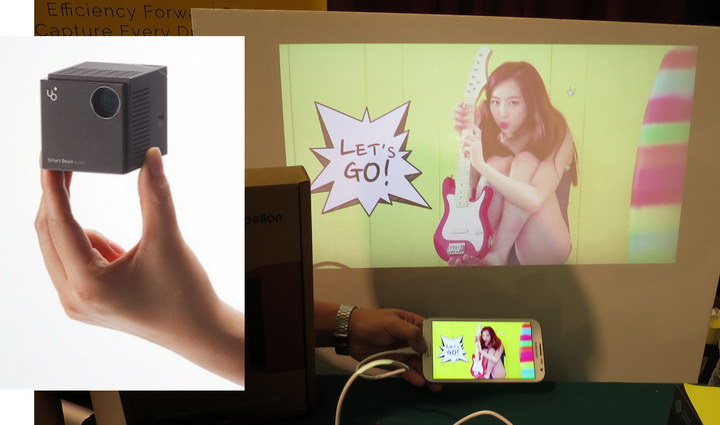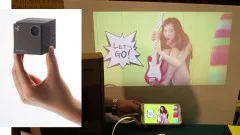United Object (UO) is a brand name launched in Korea in May of this year by Korea’s SK Telecom for its lifestyle-related products. In July, they expanded the brand into China. Now they are knocking on the door of the US market with their laser and LCoS based picoprojector (and it was previewed and reported at the Mobile World Congress and in our Infocomm Round-up – Man. Ed.)
The Smart Beam Laser picoprojector uses RGB laser illumination and a 720p (1280×720) HD LCoS microdisplay in a color sequential system to produce 60 lumens at the screen, according to the company. (The Korean language website claims 100 lumens.) This comes in a 55mm x 55mm x 55mm (2.2” x 2.2” x 2.2”) package that weights 195g (6.9 oz.). This includes the internal 4200mAH battery, said to be capable of powering the projector for 120 minutes. There is also an internal 1W speaker. UO claims the projector is good for images in the 20” – 100” (50cm – 254cm) range.

I had a chance to see one of these projectors in operation at a Pepcom event September 30th. The image source for the projector was a Samsung smartphone and the projector was making a surprisingly acceptable image in the well-lit show floor. The projector was connected to the Android smartphone wirelessly. In addition to the expected HDMI and MHL inputs, the projector can connect wirelessly, via DLNA and Miracast. Sorry, Apple fans, neither OS X nor iOS support either DLNA or Miracast so, for the time being, only Windows or Android users can connect wirelessly. Apple users will have to connect the old fashioned way, via a copper cable.
As can be seen in the photo, on the well-lit show floor, the roughly 20” image was somewhat washed out with the colors desaturated compared to looking at the phone directly. In the shadow being cast on the screen, you can see the colors are significantly better than outside the shadow region. The cable attached to the Samsung phone in the photo connects the phone to its battery charger, not to the projector. The projector was operating completely wirelessly, using its internal battery and Miracast. Considering how well the picoprojector did with a 20” image in the well-lit room, the 100” image claim may not be much of an exaggeration for a completely dark room.
James Chang, VP of Marketing for the UO Laser projector, told me he was just using a piece of poster board as a screen so the gain would have been around 1.0 or so. I looked but didn’t notice any laser speckle in the image. Chang added that the UO Laser projector was a Class 1 laser device, since the laser beams were spread out over the surface of the LCoS imager. He said that a scanned laser projector with the same 60 lumen output would qualify as a Class 3R laser device and would have restrictions on its use. There are no laser safety restrictions on the use of the UO Laser projector.
The UO Laser projector is shipping now from the UO website (http://www.uobeam.com/) in the US and Canada at an introductory price of $420. Presumably, Korean and Chinese customers can get units though Asian websites. The company is not currently shipping to Europe or other regions. –Matthew Brennesholtz
At Mobile World, we heard that the imager for this device is being made by Syndiant (BR)

